Native plants for Michigan landscapes: Part 1 – Trees
Native plants are a great addition to the landscape to provide a thrifty, no-nonsense landscape for years to come.
This is Part 1 in a two-part series on Native Trees and Shrubs for the Michigan Landscape. Read Part 2 - Shrubs.
Beautiful landscapes begin with a strong foundation of woody trees and shrubs. Beyond the popular array of easy-to-find exotic plants, there are many native plants that can provide natural beauty and enhanced habitat for wildlife. When properly selected and placed, native plants also benefit our environment through reduced water use and less need for pesticides and fertilizers. To top it all off, native plants can result in lower long term maintenance costs, increased plant hardiness and less work.
A word of caution when considering natives: Native plant promotions sometimes claim the benefit of “no care” and “no maintenance.” Unfortunately, this isn’t true. While we would all love a no-work garden, just like any plant in your landscape, native plants do require care.
What’s native?
These plants naturally occur in a particular region, ecosystem or habitat without human intervention. These plants were present at the time Europeans arrived in North America. Some people have a very narrow geographic focus for their definition of “native” while some are content as long as the plant is native to North America. Regardless of your definition, there are many plants to choose from. In fact, gardeners may be surprised to discover that some popular trees and shrubs (i.e. honeylocust, Kentucky coffeetree, Juneberry, potentilla, ninebark, and several viburnums) are actually native to Michigan.
Being successful
The key to success with native plants is carefully choosing plants that match your site conditions. While some native plants are tremendously adaptable to a wide range of environmental conditions, many are quite habitat-specific. Before you start selecting plant material, know your site, including the exposure, soil texture, pH, fertility, moisture conditions, weed problems, and the history of use. Try to match the site’s conditions to the plant’s natural habitat. Some discrepancies can be corrected with soil amendments, mulching, fertilization, and other techniques, but these solutions may not overcome a poor match between your selected plant and site.
Remember that while your landscape may be in the plant’s native range, it is important to understand that most residential sites, particularly in urban areas, no longer resemble original site conditions. Soil may have been disturbed or subsoil placed on the surface. Sites may have been further altered through compaction, pollution, salt runoff and removal of canopy trees that use to provide shade. The survival and growth potential of native species in these conditions may be no better or worse than non-native species.
For urban gardens, consider plants that are native to wet soils. Many plants native to river bottomlands are surprisingly adaptable to urban conditions. In their natural environment, these plants experience extreme fluctuations in soil moisture and oxygen. Researchers have found that these plants often can adapt to compacted, overly dry, or overly wet soils that are common to urban areas.
Here are a few examples of native trees and shrubs to consider for Michigan landscapes.
White Oak (Quercus alba), 60 feet tall. Pyramidal when young, upright rounded to broad-rounded habit with wide spreading branches at maturity. Foliage is dark green changing to wine-red in fall. Slower growing and more difficult to transplant than the other oaks but not as susceptible to insects and diseases and grows on a wide range of soil types.
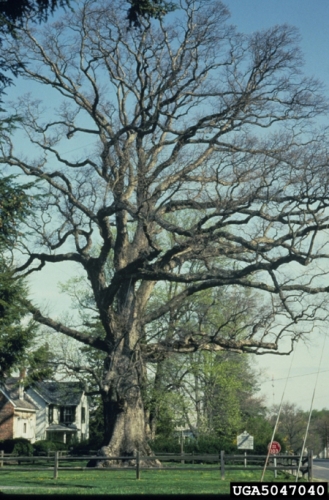
Stately, mature white oak in early spring. Photo credit: Martin MacKenzie, Bugwood.org.
Bur Oak (Quercus macrocarpa), 50-70 feet tall. Tough plant found in a variety of site conditions from seasonally wet to dry, open to shaded. Yellow-brown fall color. More tolerant of urban pollutants than other oaks.
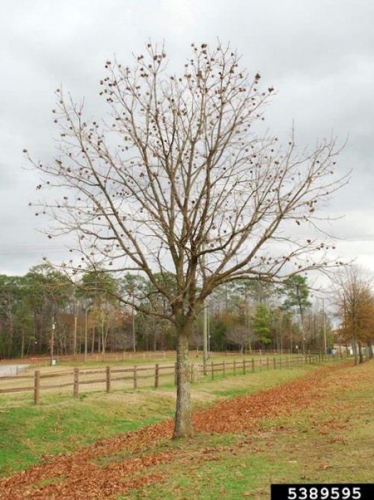
Young bur oak. Photo credit: Nancy Lowenstein, Bugwood.org.
Red Oak (Quercus rubra), 60 feet tall. Quick-growing and best on moist, well-drained, forested sites. Leaves emerge a pink-red in spring, turning a dark green above and paler beneath in summer. Autumn brings beautiful, red leaf color. Long-lived, strong-wooded. More cold-tolerant than black or white oaks and provides a stately form in winter.
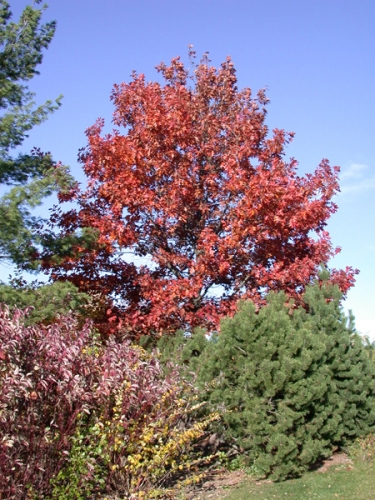
Red oak displaying beautiful red fall color. Photo credit: Mary Wilson.
Kentucky Coffeetree (Gymnocladus dioicus), 50 feet tall. Huge compound leaves give this tree a tropical feel, while the arching branches present an elm-like form. Picturesque in winter with deeply furrowed bark and stout branches. Prefers deep moist soil but is adaptable to adverse conditions. Excellent cold hardiness and no known pest problems. Tolerant to drought and urban conditions.
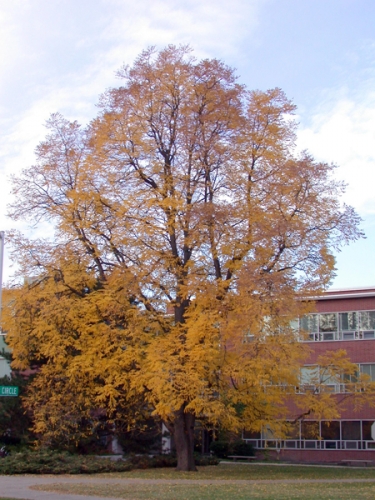
Mature Kentucky coffeetree in fall. Photo credit: Mary Wilson.
Black Gum (Nyssa sylvatica), 30-40 feet tall. Slow-growing with lustrous foliage that transforms to vivid shades of orange, scarlet and yellow in autumn. Dark, blochy bark and unique branching pattern provides winter interest. Fruit readily eaten by birds and squirrels. Low-maintenance and tolerates wet, clay soils as well as salt. Slow to establishing urban areas; native areas –moderately fast. Excellent specimen tree.
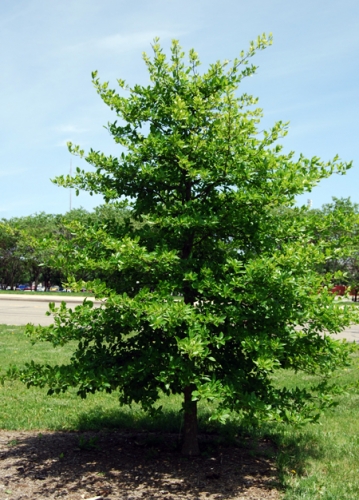
Young black gum in urban park. Photo credit: Mary Wilson.
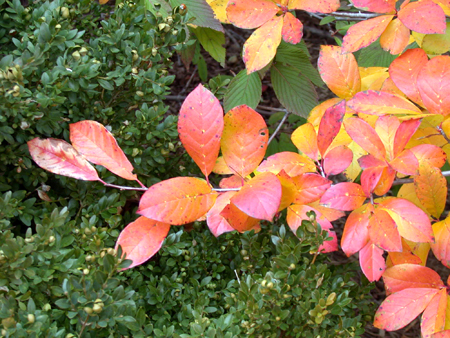
Fall color on black gum tree. Photo credit: Mary Wilson.
Hophornbeam (Ostrya virginiana), 40 feet tall. Medium-sized trees noted for its fruit, which resemble clusters of hops. Considered difficult to transplant but very tough once established. Useful in dry locations for lawns, parks, naturalized areas and street trees.
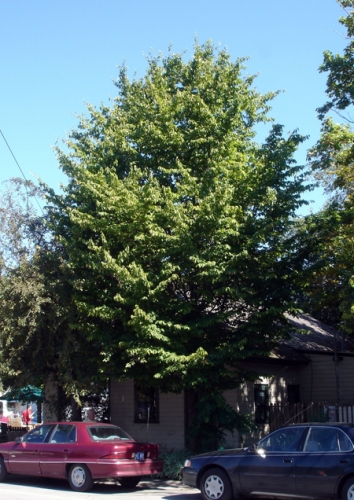
Hophornbeam growing along street in Michigan. Photo credit: Mary Wilson.
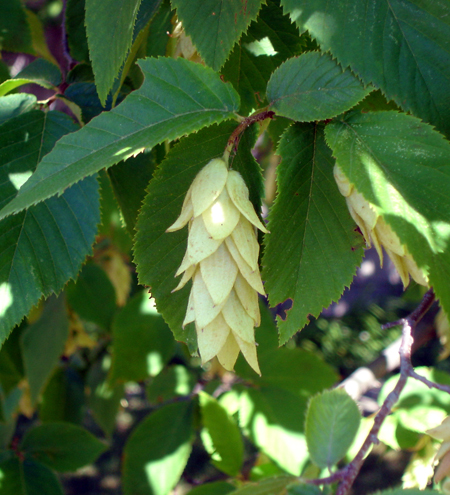
Hop-like fruit of Hophornbeam tree. Photo credit: Mary Wilson.
Serviceberry, Juneberry (Amelanchier laevis and A. canadensis) – 20’ - Excellent landscape plant that is easy to grow. Provides year-round interest and excellent edible fruit. Great in the naturalized border, specimen plant or along the foundation. Full sun to partial shade; understory tree seen throughout the countryside when it’s in flower.
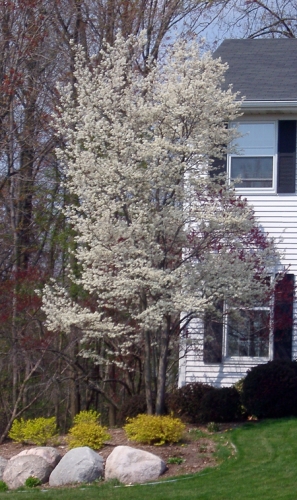
Juneberry in early spring. Photo credit: Rebecca Finneran.
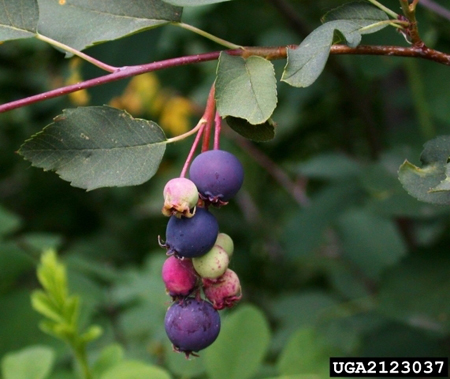
Edible blueberry-like fruit of Juneberry. Photo credit: Mary Ellen Harte, Bugwood.org.
Alternate Leaved Dogwood (Cornus alternifolia), 15-20 feet all. Frequently overlooked for landscape consideration. Offers a wonderful horizontal branching pattern that works great to break up vertical elements in the landscape. Plant bears clusters of small white flowers and bluish-black berries. Leaves turn reddish in fall. Prefers partial shade but does well in full sun.
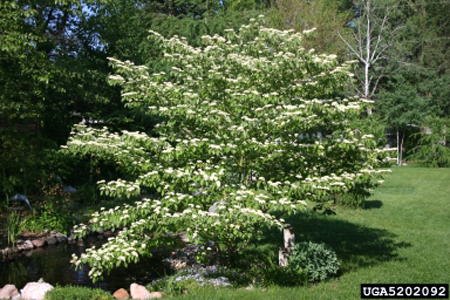
Alternate-leaved dogwood in May. Photo credit: Steve Katovich, Bugwood.org.
Common Paw Paw (Asimina triloba), 15 feet tall. Small tree with a short trunk and spreading branches forming a dense pyramid or round topped head. Often suckers. Large, dark green summer foliage gives the tree a tropic appearance. Edible brownish-black fruit taste similar to a banana, high in vitamins A and C. Plant more than one for pollination. Can be used for naturalizing or along the water’s edge.
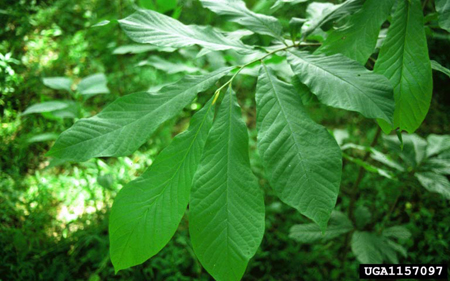
Large leaves of Paw Paw in summer. Photo credit: David J. Moorehead, Bugwood.org.
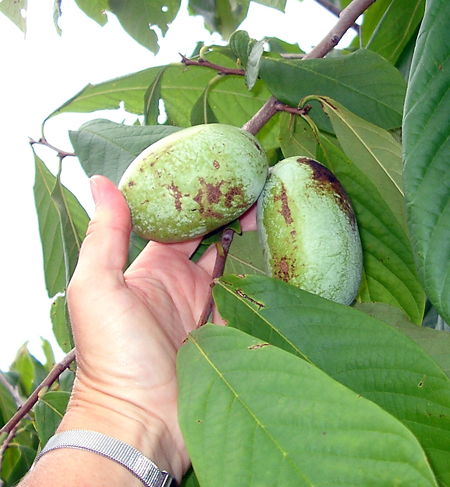
Edible fruit of Paw Paw. Photo credit: Rebecca Finneran.
Suggestions of several native shrub species for smaller areas in your landscape can be found in Part 2 of this series.
Related resources on water use or drought
- Excess drying leads to poor mulch performance, Rebecca Finneran, MSU Extension.
- Gardening tips for wise use of your water resources, Mary Wilson, MSU Extension
- Impacts of summer weather on landscape plants, Stephen Fouch, MSU Extension
- Silence of the soaker hoses, Gretchen Voyle, MSU Extension
- Tough plants for tough places: Grasses, Rebecca Finneran, MSU Extension
- Water saving perennials: Carefree and beautiful without the fuss, Rebecca Finneran, MSU Extension
For additional gardening information, call the MSU Extension Lawn and Garden Hotline at 1-888-MSUE-4MI (1-888-678-3464). You can also visit www.migarden.msu.edu



 Print
Print Email
Email




